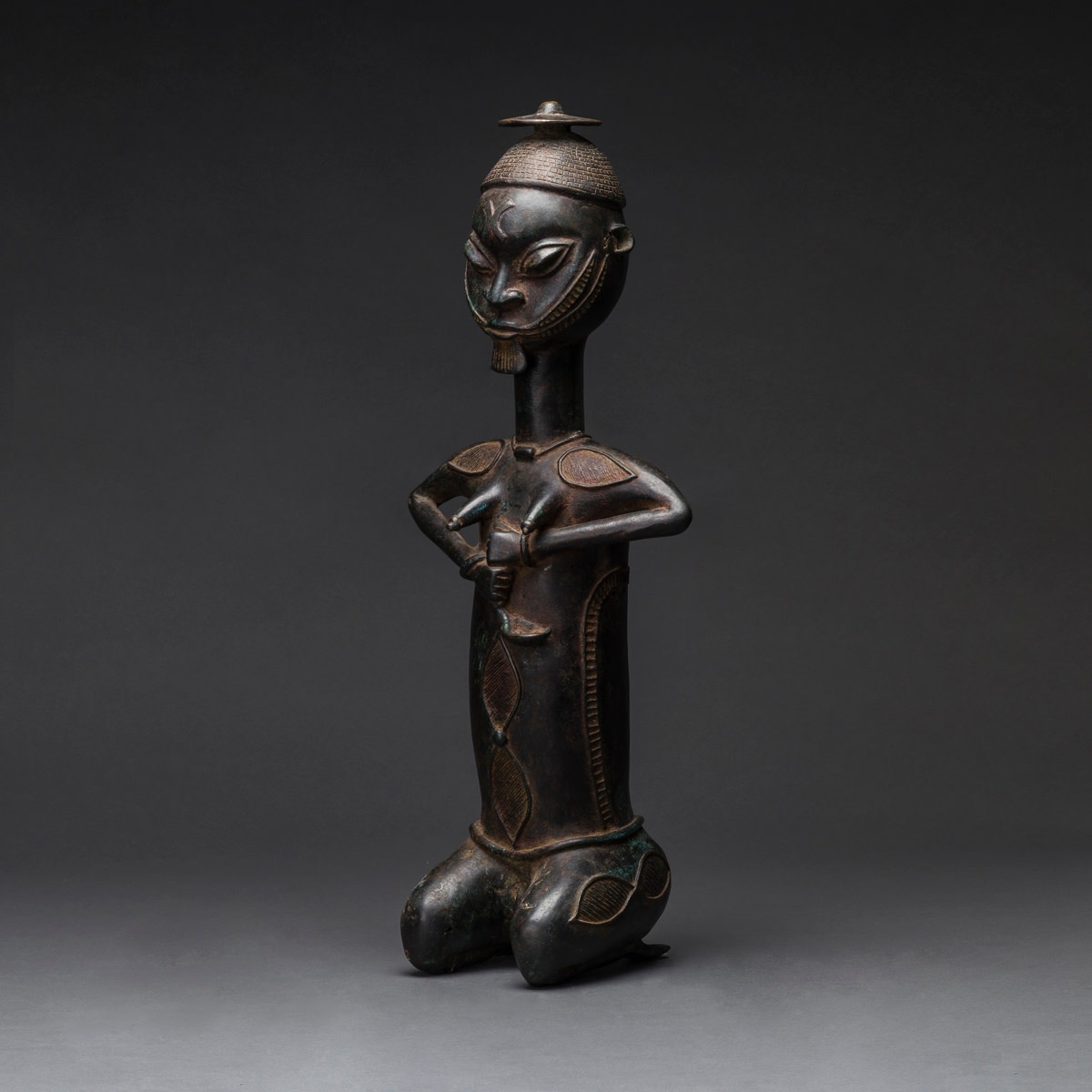Yoruba Brass Onile Sculpture of a Kneeling Woman, 20th Century CE
Brass
23 x 9.5 cm
9 1/8 x 3 3/4 in
9 1/8 x 3 3/4 in
BF.132 (LSO)
Further images
This dramatic figure of a kneeling woman was made by artesans of the Yoruba polity, in modern-day Nigeria. It is an Onile sculpture, one of a male/female pair, which was...
This dramatic figure of a kneeling woman was made by artesans of the Yoruba polity, in modern-day Nigeria. It is an Onile sculpture, one of a male/female pair, which was displayed by the Ogboni society. The torso is extremely long, with short legs tucked under the body, and spindly arms – one hand holding a spoon – crossed on the chest. The neck is very elongated and thin, with a rounded head, bearing a serene expression. Despite the evidently female gender, the figure has a beard; it may thus be a hermaphrodite. The head is capped with a domed cap, bearing a small, flat platform. The eyes are downcast, and there is a cruciform eminence on the forehead. The body is essentially naked except for a loincloth (?) and a series of leaf-shaped adornments on the shoulders and the abdomen. The patina is sporadically dark but uneven.
The Yoruba are a Central Nigerian tribal group, originally descended from a Hausa migration from the northeast in about 900 AD. A small kingdom – Ile Ife – was founded by Oduduwa, followed by great sociopolitical expansion into Southwest Nigeria, Benin, and Togo. Communities were presided over by the Oba (king) and various senates (Ogboni), and councils made up of guild leaders, merchants and the lesser aristocracy (related to the Oba). The Yoruba have an exceptionally rich and diverse mythology, history and religious context (Itan), all of which are directly linked to their artistic output.
Ogboni is a Yoruban institution that exercises social, judicial and sociopolitical power over the populace and even exercises control over regents in local monarchies. They are gerontocratic, generally benign, and focused upon the veneration of the earth (Ile or Odua). Membership of the Ogboni is a major indicator of status in Yoruba society, and this status is reinforced through the commissioning of religious and courtly paraphernalia. Most Ogboni pieces – which include jewellery and sculptures –are made of brass/copper, the non-rusting character of which is viewed as a metaphor for immortal functions and beliefs of the members. Perhaps the best known Ogboni symbol is the initiates or “edan” figures, a pair of naked male and female figures that are worn around the neck on a chain. The current piece is too large for this, and is most probably an Onile figure, which were displayed on altars in the meeting houses of the society. While males and females were shown, it refers to the duality of a female goddess (Ile) of the earth, who had harder and softer aspects to her personality.
The age of this piece is hard to determine, but the patina is consistent with a comparatively late date. This is an impressive piece of African art.
The Yoruba are a Central Nigerian tribal group, originally descended from a Hausa migration from the northeast in about 900 AD. A small kingdom – Ile Ife – was founded by Oduduwa, followed by great sociopolitical expansion into Southwest Nigeria, Benin, and Togo. Communities were presided over by the Oba (king) and various senates (Ogboni), and councils made up of guild leaders, merchants and the lesser aristocracy (related to the Oba). The Yoruba have an exceptionally rich and diverse mythology, history and religious context (Itan), all of which are directly linked to their artistic output.
Ogboni is a Yoruban institution that exercises social, judicial and sociopolitical power over the populace and even exercises control over regents in local monarchies. They are gerontocratic, generally benign, and focused upon the veneration of the earth (Ile or Odua). Membership of the Ogboni is a major indicator of status in Yoruba society, and this status is reinforced through the commissioning of religious and courtly paraphernalia. Most Ogboni pieces – which include jewellery and sculptures –are made of brass/copper, the non-rusting character of which is viewed as a metaphor for immortal functions and beliefs of the members. Perhaps the best known Ogboni symbol is the initiates or “edan” figures, a pair of naked male and female figures that are worn around the neck on a chain. The current piece is too large for this, and is most probably an Onile figure, which were displayed on altars in the meeting houses of the society. While males and females were shown, it refers to the duality of a female goddess (Ile) of the earth, who had harder and softer aspects to her personality.
The age of this piece is hard to determine, but the patina is consistent with a comparatively late date. This is an impressive piece of African art.





